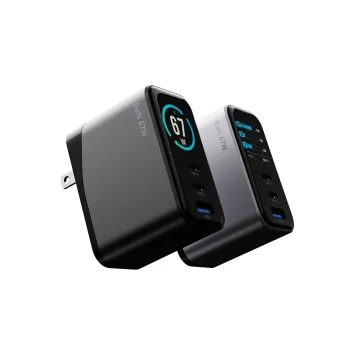GaN vs PD Charger | ZONSAN
Updated November 2025
The fast-charging industry has come a long way — but two terms still dominate every charger discussion: GaN and PD.
Since the first GaN chargers hit the market around 2019 and USB Power Delivery (PD) became a universal fast-charging standard, these technologies have redefined how quickly and safely we power our devices.
In 2025, 2026, the question isn’t “Which is better?” — it’s “How do GaN and PD work together?”
Let’s break down their differences, updates.

⚙️ 1. What Is a GaN Charger?
GaN (Gallium Nitride) is a next-generation semiconductor material that replaces traditional silicon (Si) in charger components.
It enables smaller, cooler, and more efficient power conversion — ideal for compact, high-wattage fast chargers.
🔧 GaN Advantages
• Smaller size, higher efficiency: Converts AC to DC with less energy loss.
• Lower heat generation: Safer and more stable under high loads.
• Supports higher power density: Allows 65W, 100W, even 240W outputs in pocket-sized designs.
• Longer lifespan: Withstands higher temperatures and voltage stress.
🔍 Example
A traditional 65W charger is about 65 × 65 mm, while a 65W GaN charger can be 40% smaller (35.5×35.5×56 mm)— perfect for travel or multi-device users.
🧠 In short: GaN refers to the hardware technology inside the charger.
⚡ 2. What Is a PD Charger?
PD (Power Delivery) is a charging protocol, not a material.
It’s the communication standard that tells your charger how much power your device needs — safely and intelligently.
📚 PD Evolution Timeline
| Version | Released | Max Power | New Features |
| PD 3.0 | 2017 | 100W | Introduces PPS (Programmable Power Supply) |
| PD 3.1 | 2021 | 240W | Supports laptops, monitors, and power tools |
| PD 3.2 | 2025 | 240W+ | Adds AVS (Adjustable Voltage Supply) and DPS (Direct Power Supply) |
🧠 In short: PD refers to the charging protocol or language between charger and device.
🔌 3. GaN vs PD: The Core Difference
| Feature | Gan Charger | PD Charger |
| Definition | Semiconductor technology | Charging communication protocol |
| Function | Improves power conversion & efficiency | Regulates power output via negotiation |
| Role | Hardware | Software/firmware |
| Can one exist without the other? | Yes - GaN charger can support PD, QC, PPS, etc. | Yes - PD charger can be Si or GaN-based |
| Best scenario | Combined use: GaN + PD for max efficiency & speed |
📈 4. Market trends from 2019 to the present: GaN + PD Leads the Fast-Charging Race
The GaN + PD charger is the current market mainstream because it delivers both hardware and software optimization
According to a 2025 market analysis by TrendForce and Statista:
• The GaN charger market is projected to exceed USD 2.1 billion by 2027.
• PD chargers are now the standard for all USB-C devices in Europe, driven by the EU’s universal charging directive.
• OEM demand for 65W, 100W, 120W, and 140W GaN PD chargers continues to surge, especially for laptop and smartphone bundle orders.
GaN and PD are no longer separate trends — they define the core direction of the next-generation charger ecosystem.
🧠 5. How to Choose the Right Charger: OEM Buyer’s Guide
When sourcing GaN or PD chargers from manufacturers, focus on:
🔍 Technical Factors
• Power Rating: 20W–240W range, matching your target device lineup.
• Protocol Support: PD, PD 3.1/3.2, PPS, QC 5.0, AVS/DPS.
• Chipset: Use reputable brands.
• Thermal Control: Multi-layer protection and temperature sensors.
🏭 Factory Capabilities
• BSCI, GRS, ISO9001-certified manufacturing
• CE, RoHS, CB, KC, FCC, ETL, EAC, ERP approvals
• Automatic production lines & SMT facilities
• OEM/ODM customization (shell, PCB, logo, color)
💡 For 2025 buyers: Choose factories that already mass-produce GaN + PD hybrid chargers, as this ensures long-term compatibility and certification readiness.
❓ FAQ
Q1: Are all GaN chargers PD-compatible?A: Most are, but not all. Always confirm PD protocol support (e.g., PD 3.1 or 3.2) in the product specs.
Q2: Can a PD charger be non-GaN?
A: Yes. Some lower-cost PD chargers still use silicon components.
Q3: What’s better for laptops — GaN or PD?
A: Both. Choose a GaN PD charger with 65W – 140W output for best performance.
Q4: Are GaN chargers safe?
A: Yes. They meet strict global safety standards and include temperature, overvoltage, and surge protection.
Q5: What are the latest trends for the future??
A: PD 3.2 + AVS/DPS support, ultra-slim GaN chargers, and multi-port desktop PD hubs.
🎯 Conclusion
In the evolving world of fast charging, GaN and PD are not competitors — they are partners.
GaN brings efficiency, smaller size, and higher power density, while PD delivers intelligence and universal compatibility.
🔗 Recommended Reading
• What Is a PD Charger and How to Choose One
• AVS vs PD vs PPS: What’s the Difference?
• The Pros and Cons of GaN Chargers
• How to Read Charger Parameters Like a Pro
OEM GaN Charger Recommendation

Read More

Read More

Read More